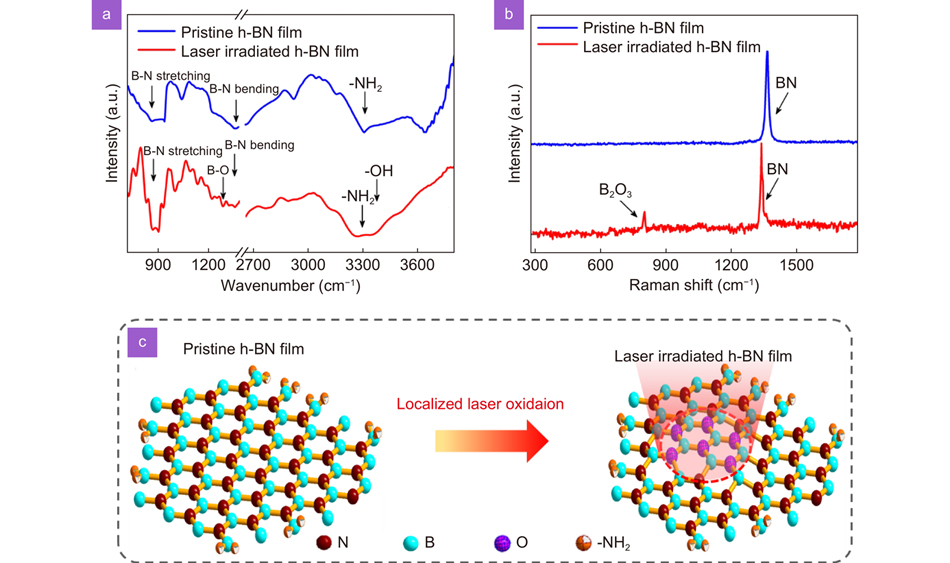Jun Ren, Han Lin, Xiaorui Zheng, Weiwei Lei, Dan Liu, Tianling Ren, Pu Wang, Baohua Jia. Giant and light modifiable third-order optical nonlinearity in a free-standing h-BN film[J]. Opto-Electronic Science, 2022, 1(6): 210013
Search by keywords or author
- Opto-Electronic Science
- Vol. 1, Issue 6, 210013 (2022)

Fig. 1. (a ) Photo of the freestanding vacuum-assisted filtrated h-BN film. (b ) TEM image of the prepared h-BN nanosheets by drop coating the ball-milled h-BN solution on a carbon-coated copper grid. (c ) HRTEM image of the h-BN nanosheets with five layers. (d ) Laser patterned micro-pattern of an Australian map on a free-standing h-BN film.

Fig. 2. (a ) FTIR spectra of the pristine h-BN film (blue line) and laser irradiated h-BN film (red line). (b ) Raman spectra with laser excitation at the wavelength of 532 nm of the pristine h-BN film (blue line) and laser irradiated h-BN film (red line). (c ) Atomic structure of pristine h-BN film and localized oxidation area after laser irradiation (red dash area).
Fig. 3. (a ) UV-VIS absorption characterization in the pristine h-BN film (blue line) and the laser patterned area (red line). (b ) The refractive index (n0) of the pristine h-BN film (blue line) and laser patterned area (red line). (c ) The extinction coefficient (ĸ) of the pristine h-BN film (blue line) and laser patterned area (red line).
Fig. 4. (a ) Open aperture Z-scan results before laser oxidation. (b ) Close aperture Z-scan results before laser oxidation. (c ) Open aperture Z-scan results after laser irradiated optical breakdown. (d ) Close aperture Z-scan result after laser oxidation.
Fig. 5. (a ) The measured nonlinear absorption coefficient β and (b ) nonlinear refractive index n2 of the pristine h-BN film. (c ) The measured nonlinear absorption coefficient β and (d ) nonlinear refractive index n2 of the laser oxidized h-BN film.
Fig. 6. FWM spectra of the h-BN film excited with pump wavelengths (865 nm, 1200 nm), compared to that of a standard gold film.
|
Table 1. The compared results of different kinds of h-BN with their nonlinear absorption coefficient β, nonlinear refractive index n2, the imaginary part Imχ(3) and the real part Reχ(3) and the effective third-order susceptibility |χ(3)| of complex third-order susceptibility χ(3).

Set citation alerts for the article
Please enter your email address



